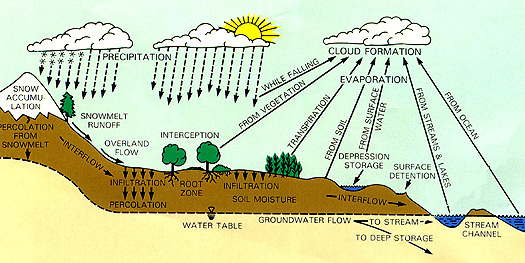

Clearly, we need some answers, if we are to understand our planet's physical and biological phenomena and how they interact, and to determine human contributions to global change phenomena. We need this information so we can make decisions to reduce any detrimental changes we cause, or to adapt to circumstances we cannot change. We must collect data that allows us to understand the basic forces and rhythms of our planetary system, and to distinguish global changes due to natural effects from those due to human activities. This global analysis, in turn, requires us to acquire data about virtually every aspect of the Earth system over a long enough period that we can see contributions from long-term phenomena (e.g., an 11-year Solar cycle) and trends. Then, we must use the data to generate information that helps planners and policy-makers to ensure a sustainable environment for all of us.
Earth System Science
The evolution of the new field of Earth System Science over the last twenty years is largely the logical consequence of
(1) the growing interest in and concern for the environment
(2) the increasing awareness that biological and physicochemical Earth processes and activities often are mutually interlocked or influential, so that each controls the other to some extent
(3) the recognition that many key processes act on a regional, and often global, scale and we must examine and interpret them at those levels
(4) the realization that many scientists work in fields and subfields in the Earth sciences that are interrelated and share similar study topics and methods, and hence they would benefit by working together in teams
(5) technology advancing to allow global monitoring (from space).
Its hallmark, then, is that it is an interdisciplinary (multidisciplinary) scientific endeavor made by specialists in aspects of Earth science working together with biologists, chemists, and physicists to investigate a wide range of physical and biogeochemical activities that affect the environment (including resources). They do this by treating Earth as a complex but integral system of entities. They concentrate on its functions from a total, or full-Earth, vantage point, i.e., primarily from the global perspective. As now developed, Earth System Science works with the knowledge associated with three major, natural, dynamic, operations: the hydrologic cycle, the physical climate system, and biogeochemical cycles. A prime goal for studying these is to determine how they interact. Put another way, Earth System Science studies relevant components, interactions and exchanges, and ecological ramifications among the following arbitrary "spheres," each defined by its own sets of characteristics and internally-related activities and subsystems: Geosphere; Ocean (sphere); Hydrosphere; Atmosphere; Cryosphere; and Biosphere.
16-9: Many universities still don't offer courses called "Earth System Science". What two courses taught for decades in the past come closest to ESS in content? ANSWER
In keeping with the Huttonian Doctrine ("the present is the key to the past" (and probably to the future, as well [writers' addition]), many of the processes have operated continuously at time scales ranging from minutes to vast millenia. Most of these processes also perform at different spatial scales, ranging from local to subcontinental or over vast oceans. For the atmospheric system, the range is at a global horizon. We synopsize this idea in this generalized space-time diagram:

This diagram suggests that we must study some processes over relatively small regions and short time frames, whereas others require worldwide monitoring over extended periods (often beyond a human life span). Nevertheless, even for the latter, we can glean useful information from determining the magnitude and frequencies of changes within the processes, as they proceed through time and shift in space. Changes affecting large segments of, or even the entire planet will likely have profound effects within the global system.
16-10: What parts of the above time-size plot are not especially favorable to satellite observations? ANSWER
Next, we show a few flow diagrams that give some indication of the intricately convolved components and areas (topics) of import to any of the systems-singly or combined-as they persistently modify the processes acting within them.

This deceptively simple diagram is similar to those found in nearly all textbooks on environmental science, physical geology, and meteorology. It shows the pattern of water leaving and returning to the Earth's surface. The process is cyclic, in that, eventually, a water molecule leaving the ocean to enter the atmosphere ultimately returns to that source. The rates of movement and the quantities involved (often shown in more detailed diagrams) vary among the specific processes (and within a process this variation changes in place and time of year). But, in the long run, the cycle continues, such that the various amounts maintain an overall mass balance, neglecting losses to outer space and gains from meteorites.

Primary Author: Nicholas M. Short, Sr. email: nmshort@epix.net
Collaborators: Code 935 NASA GSFC, GST, USAF Academy
Contributor Information
Last Updated: September '99
Webmaster: Bill Dickinson Jr.
Site Curator: Nannette Fekete
Please direct any comments to rstweb@gst.com.